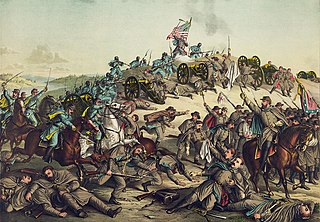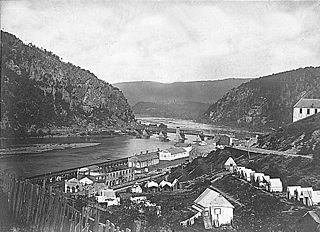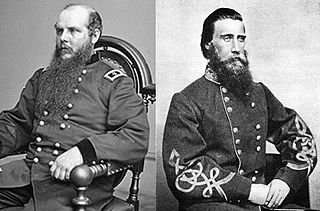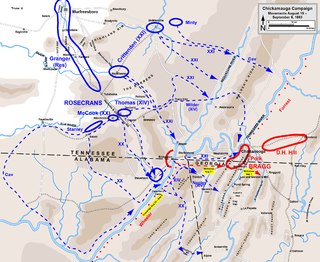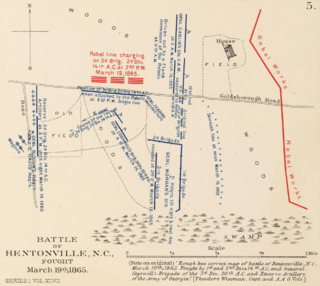This article has multiple issues. Please help improve it or discuss these issues on the talk page . (Learn how and when to remove these template messages) (Learn how and when to remove this template message)
|

The Skirmish at Pace's Ferry [1] was an engagement fought on July 5, 1864, near Pace's Ferry, Atlanta, Georgia, during the Atlanta Campaign of the American Civil War. [2] Union troops of Maj. Gen. Oliver O. Howard seized a key pontoon bridge over the Chattahoochee River, enabling Federal troops to continue their offensive to capture the important rail and supply center of Atlanta.
Through much of the 19th century, Pace's Ferry was an important ferry across the Chattahoochee River near Atlanta. Started in the early 1830s near Peachtree Creek, it was run by Hardy Pace, one of the city's founders. It was an important transportation link to northwestern Georgia, especially prior to the construction of the State Road to Chattanooga.

Atlanta is the capital and most populous city in the U.S. state of Georgia. With an estimated 2017 population of 486,290, it is also the 38th most-populous city in the United States. The city serves as the cultural and economic center of the Atlanta metropolitan area, home to 5.8 million people and the ninth-largest metropolitan area in the nation. Atlanta is the seat of Fulton County, the most populous county in Georgia. A small portion of the city extends eastward into neighboring DeKalb County.

Georgia is a state in the Southeastern United States. It began as a British colony in 1733, the last and southernmost of the original Thirteen Colonies to be established. Named after King George II of Great Britain, the Province of Georgia covered the area from South Carolina south to Spanish Florida and west to French Louisiana at the Mississippi River. Georgia was the fourth state to ratify the United States Constitution, on January 2, 1788. In 1802–1804, western Georgia was split to the Mississippi Territory, which later split to form Alabama with part of former West Florida in 1819. Georgia declared its secession from the Union on January 19, 1861, and was one of the original seven Confederate states. It was the last state to be restored to the Union, on July 15, 1870. Georgia is the 24th largest and the 8th most populous of the 50 United States. From 2007 to 2008, 14 of Georgia's counties ranked among the nation's 100 fastest-growing, second only to Texas. Georgia is known as the Peach State and the Empire State of the South. Atlanta, the state's capital and most populous city, has been named a global city. Atlanta's metropolitan area contains about 55% of the population of the entire state.
Union Maj. Gen. William T. Sherman's army had steadily advanced towards Atlanta in the spring and summer of 1864, fighting a series of battles against the Confederate Army of Joseph E. Johnston. Sherman continually flanked the Confederate positions and slipped ever closer to his goal. Howard's IV Corps pursued the retreating Confederates along the Western & Atlantic Railroad, with General Thomas J. Wood's division in the lead. They encountered very little resistance until the head of column reached Vining's Station. From that point, a road led to the east toward Atlanta, crossing the Chattahoochee River at Pace's Ferry, where the Confederates had constructed a pontoon bridge over the deep and swift flowing river. Wood's skirmishers encountered a brigade of dismounted cavalry, which had its front covered by rail barricades along a ridge at right angles to the road, a quarter mile from the railroad station. Wood quickly drove the Confederates from these barricades and pushed on to the river. Despite Confederate efforts to destroy the bridge to prevent it from falling into enemy hands, Wood's men arrived in time to save the greater part of the bridge. Confederate attempts to burn the structure had failed, and mooring ropes had been cut on the Confederate side so that the pontoon bridge drifted in the river. [3] [4] [5]

The Confederate States Army (C.S.A.) was the military land force of the Confederate States of America (Confederacy) during the American Civil War (1861–1865), fighting against the United States forces. On February 28, 1861, the Provisional Confederate Congress established a provisional volunteer army and gave control over military operations and authority for mustering state forces and volunteers to the newly chosen Confederate president, Jefferson Davis. Davis was a graduate of the U.S. Military Academy, and colonel of a volunteer regiment during the Mexican–American War. He had also been a United States Senator from Mississippi and U.S. Secretary of War under President Franklin Pierce. On March 1, 1861, on behalf of the Confederate government, Davis assumed control of the military situation at Charleston, South Carolina, where South Carolina state militia besieged Fort Sumter in Charleston harbor, held by a small U.S. Army garrison. By March 1861, the Provisional Confederate Congress expanded the provisional forces and established a more permanent Confederate States Army.
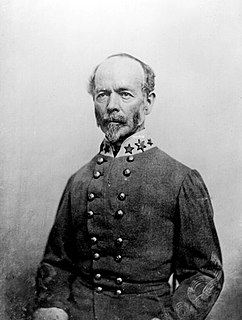
Joseph Eggleston Johnston was a career United States Army officer, serving with distinction in the Mexican–American War (1846–1848), and Seminole Wars. After Virginia seceded, he entered the Confederate States Army as one of its most senior general officers.

Thomas John Wood was a career United States Army officer. He served in the Mexican–American War and as a Union general during the American Civil War.
Not seeing a suitable opportunity to attack the strong Confederate positions across the Chattahoochee, Howard ordered his corps into camp on high ground facing the river and awaited the arrival of Federal pontoons. July 10, Stanley's and Wood's divisions moved to near the mouth of Sope Creek, in support of General John Schofield, who had crossed the river at that point (north of Pace's Ferry) and outflanked the Confederates. On July 11, at 5 p.m. Gen. Howard received "orders to secure the heights opposite Powers' Ferry, on the south side of the Chattahoochee, to protect the laying of a bridge at that point. Stanley's division fulfilled these instructions the next morning at daylight, passing the river at Schofield's bridge." [3]
Sope Creek is an 11.6-mile-long (18.7 km) stream located in Cobb County, Georgia, United States. It is a significant tributary of the Chattahoochee River. It was known as Soap Creek during the 19th century. A section of Sope Creek runs through the Chattahoochee River National Recreation Area.

John McAllister Schofield was an American soldier who held major commands during the American Civil War. He later served as U.S. Secretary of War under Presidents Andrew Johnson and Ulysses S. Grant, and Commanding General of the United States Army.


